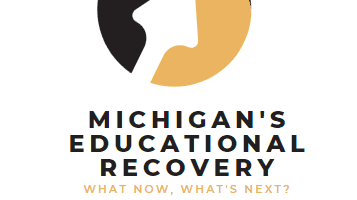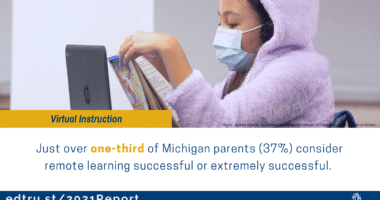Invest with Urgency in Michigan Students’ Educational Recovery
The Education Trust-Midwest recently released the 2023 State of Michigan Education Report, Beyond the Pandemic. The report highlights 10 research-based steps we can take as a state to combat educational inequities, restore unfinished learning, and set Michigan on a path to becoming a top 10 education state.
Over the next several weeks, we will dive more deeply into these strategies, starting with our recommendation to invest with urgency in Michigan students’ educational recovery.
While opportunity and achievement gaps have persisted in Michigan for a long time, the pandemic exacerbated these inequities. In some cases, districts with more students from historically underserved groups, including students facing economic hardship and students of color, saw the largest amounts of unfinished learning in the state. The Education Recovery Scorecard, a collaboration between researchers at Harvard and Stanford Universities, estimates that students in Lansing, Saginaw, and Detroit lost the equivalent of about a year or more in both reading and math. On the other hand, students in Birmingham lost the equivalent of about 20% of a school year, and students in Bloomfield Hills lost the equivalent of 4% of a school year.
It’s imperative for Michigan to address these widening disparities. Importantly, COVID relief funds intended for just that are still available.
Schools must use available dollars as soon as possible to accelerate Michigan students’ learning. As of January 2023, Michigan districts had only spent about 20% of their ARP ESSER dollars, leaving roughly $3 billion left to be spent. To this end, Dr. Marguerite Roza suggests that districts redirect these funds toward learning recovery where possible.
Two viable options to accelerate student learning include targeted intensive tutoring and expanded learning time. A recent brief by The Education Trust, “Targeted Intensive Tutoring as a Strategy to Solve Unfinished Learning,” explains what targeted intensive tutoring is, along with considerations for implementing it most effectively. This evidence-based strategy is more effective when led by certified teachers or paraprofessionals, and during the school day. While it yields positive results for students of any age, intensive tutoring is especially effective at accelerating growth for younger students in particular – with the potential to double learning in a year.
A second strategy to address unfinished learning is expanded learning time. This ETM blog defines expanded learning time as “a variety of in-school, after-school, and summer programs that can increase instructional and learning time for students.” The post goes on to summarize how effective programs can even increase average student test scores by 12 percentile points, adding, “some ELT strategies provide the equivalent of four to eight regular school months of growth.”
We owe it to Michigan students to help them recover from unfinished learning due to the pandemic, as well as address longstanding inequities in our education system. We are calling on district leaders to make sure remaining relief funds are invested wisely, effectively, and urgently to accelerate student growth.
Emily Hatch is a senior data and policy analyst for The Education Trust-Midwest.



